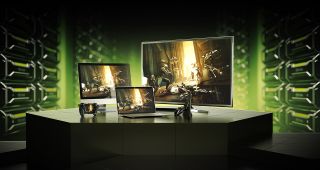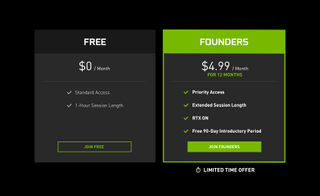Nvidia's cloud gaming service has officially launched, and you can use it for free
Beta accounts will automatically be rolled over to free accounts.

Update: Nvidia reached out clarify that beta accounts will be automatically rolled over to free accounts, not Founders accounts. However, beta members, like all users, can also upgrade to the Founders memberships which come with a 90-day free trial.
As of this morning, Nvidia's cloud gaming service, GeForce Now, has officially moved out of beta testing. If you want to put Nvidia's remote rendering to the test with the games you own, you can give it a try for free. We've done some additional testing and feel GeForce Now is what Stadia ought to be.
There are two membership tiers: free and Founders. The free membership doesn't come with special perks and is limited to 60-minute play sessions. Once your session ends you can jump right back on, but you may have to wait in a queue.
Founders members (paying members) will have access to RTX ray tracing in the cloud, so if you're still rocking a GTX 1050 Ti but want to see what all the ray tracing fuss is about, you can for $5 a month. (However, Wolfenstein: Youngblood, Call of Duty: Modern Warfare, Metro Exodus, and Deliver Us the Moon are the only four RTX enabled games on GeForce Now currently.) A paying membership also expands play sessions to 6 hours, lets you skip ahead of free players in the session queue, and comes with a free 90-day introductory period (for a limited of time). The $5 a month rate is locked in for an entire year, as well.
How well GeForce Now works will ultimately determine how we feel about it (we tested it nearly a year ago, and things could have changed since then), but on its face it's a much better offer than Google Stadia. Stadia costs $10 a month and doesn't have a free membership option yet, though Google said one would be coming this year. Also, Stadia's servers utilize AMD graphics cards, which don't currently support ray tracing.
Most importantly, to play a game through GeForce Now, you don't have to buy a separate version of it—if you own a copy of the game on Steam or in another store, you can play it through GeForce Now by connecting your account. It currently supports over 100 games, though it's missing a few you'd expect, like Control and Red Dead Redemption 2, so it leaves something to be desired in that respect. Still better than Stadia. But GeForce now will save your user names and passwords so you don’t need to log into your Steam, Epic, whatever accounts every time.
Another way GeForce Now bests Stadia is platform support: You can stream to PCs, Macs, Android phones, and Shield TVs currently. GeForce Now will add Chromebooks to that list later this year. During a news briefing, Phil Eisler, VP and GM of GeForce Now, said that support for more Android TV devices will come in the future, and that Nvidia is working with Razer to integrate GeForce Now with its mobile phone controllers.

When you break it down like that, GeForce Now seems like a far better option than Stadia out the gate, even if the latency ends up being the same. However, the disparity in play sessions between free and paid members could be an issue. While free members can re-queue after their hour is up, how long they have to wait to get back into their game depends on how many paid members are currently online, which might be a lot during peak hours.
The biggest gaming news, reviews and hardware deals
Keep up to date with the most important stories and the best deals, as picked by the PC Gamer team.
If the wait times get too long, Eisler says that Nvidia will increase its server capacity to bring them down. He doesn't expect a big rush right out of the gate.
One thing that will probably annoy free users are the pop-up notifications letting them know how much time they have left before their session ends. According to Nvidia, users will be "notified when there are 40, 30, 20 and 10 minutes, and five seconds remaining." This happens for both memberships on all platforms. If you’re a free member, your first pop-up appears 20 minutes into the session. PC users will also have a persistent warning starting at 10 minutes.

It sounds like these pop-ups could be intrusive, and the one-hour free session limit makes it hard to play multiplayer games like Overwatch and League of Legends, or games which don't let you save at any time. We'll see how this pans out in addition to our latency testing, but this is one area where Stadia has an edge: no session limits.
Also, poking around in the Founders version of GeForce Now on PC last night, the highest resolution I could set any game at was 1080p, even if I was playing on a 4K monitor. Stadia may not be able to do 4K on PC yet, but it can on mobile and TV.
If you want to get started with a free or Founders account today, here's a look at the system requirements:
- 15 Mbps internet connection (25 Mbps recommended). A 5GHz network is preferred if using wireless.
- Any Windows PC running Windows 7 (64-bit) or higher, 4GB of system memory, a 2.0GHz dual-core X86 CPU or higher and a GPU that supports DirectX 11.
- Any Mac with macOS 10.10 or higher.
- Any Nvidia Shield TV (2015, 2017, 2019; Base and Pro models).
- Any Android phone running Android 5.0 (L) or higher and 2GB of system memory.
- A Bluetooth gamepad is strongly recommended, including the Shield controller, Razer Raiju and Junglecat Mobile, or Steelseries Stratus Duo.
Stay-tuned for our GeForce Now review and latency testing later this week.

Nvidia's upgrading GeForce Now's $10 tier with 1440p and Ultrawide resolutions, but the only extra Ultimate users get is a new 100-hour play limit

Intel CEO sees 'less need for discrete graphics' and now we're really worried about its upcoming Battlemage gaming GPU and the rest of Intel's graphics roadmap
Most Popular







